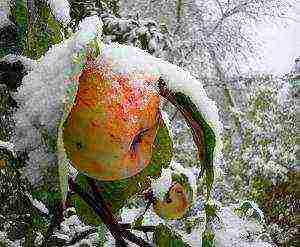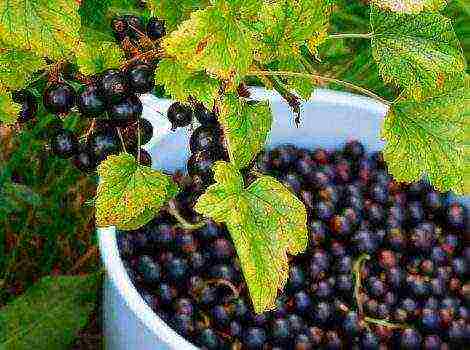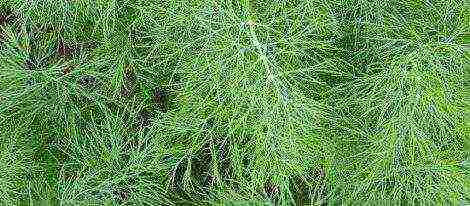Content
- 1 What varieties of plums are most suitable for giving
- 2 Early varieties of plums
- 3 Mid-season plum varieties
- 4 Late varieties of plums
- 5 The best varieties of plums
Gardeners consider the plum to be almost the most whimsical fruit tree. But the taste of juicy sweet fruits is worth the work and hassle that a farmer does when caring for his garden. Today there are many varieties of plums that are suitable for different regions, therefore, when choosing seedlings for planting, you need to pay attention to their characteristics. In a huge assortment, every gardener will be able to find a variety that suits him.
Alyonushka
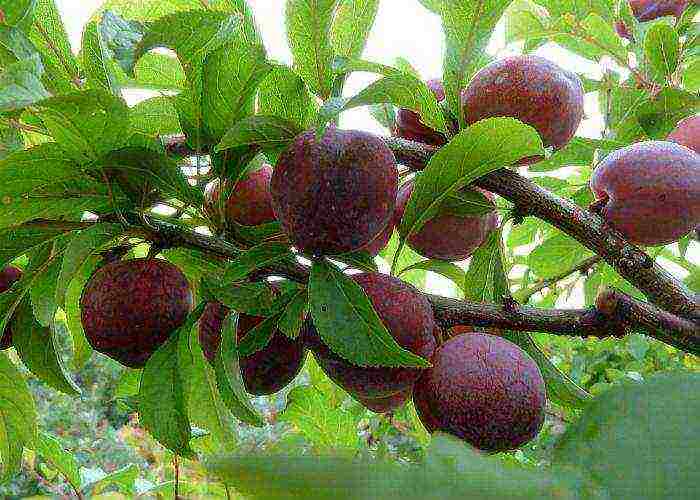
Plum variety with early ripeness. The height of the tree usually does not exceed 3 meters. The fruits are rounded, they reach 40 mm in diameter, weigh 30-40 grams, the skin tone is deep red. The pulp is medium-dense, juicy, orange color, sweet and sour taste. When ripening, the fruits do not crack, the variety is frost-resistant and practically immune to most ailments that plums get sick with.
Back to contents ↑ Anna Shpet
Late-ripening fruitful variety, bred by the German breeder L. Shpet. The plant is tall and durable. The fruits are oval, less often ovoid, even on the sides, weighing up to 50 grams each, the color of the dense skin is violet-red, there is a waxy bloom, the pulp density is good, the color is yellow-green. The variety tolerates wintering and dry weather relatively well, but is often affected by various ailments.
Back to contents ↑ Bogatyrskaya
A mid-ripening variety of self-fertile plum. The tree grows short. Fruits are formed of medium size, their average weight is 40 grams, the skin color is deep purple, with the presence of a waxy coating, the shape is slightly elongated oval. The pulp tastes sweet and sour, its color is yellow-green. The variety is resistant to cold weather, the fruits tolerate transportation well, the plants are poorly exposed to diseases.
back to contents ↑ Hungarian
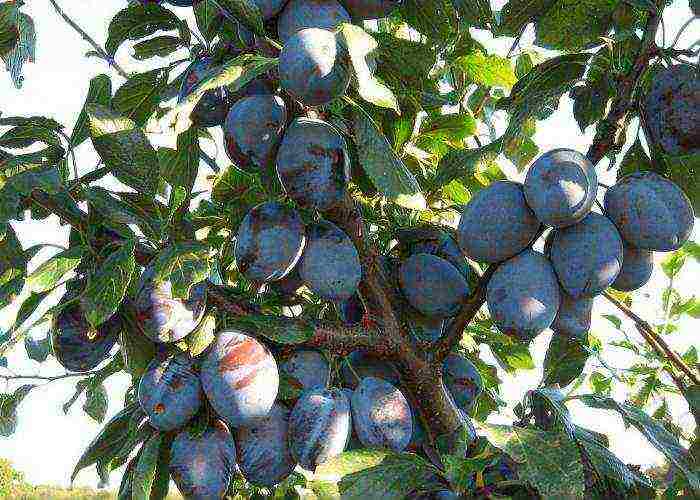
A variety with a late period of reaching full fruit ripeness. The tree is medium-sized, the variety is large-fruited, the weight of its fruits is 100 grams, the skin has a blue-violet color, a waxy bloom is present. The pulp is juicy, sweet in taste, the density is average. The variety is valued for its regular yield and immunity to the main ailments affecting the plum, this variety is one of the best for the Moscow region.
back to contents ↑ Volga beauty
The fruits reach a weight of about 40 grams, the shape is round, slightly elongated, the density of the pulp is medium, dark yellow in color, the taste is sweetish-sour, the fruits are covered with a purple skin. This variety is universal, it survives the wintering painlessly, the fruits retain their qualities during long-term transportation.
back to contents ↑ Eurasia
Early ripening variety of table plum. The height of an adult plant usually does not exceed 5 meters, the plant is medium spreading. The shape of the fruit is round, the color of the thin skin is dark blue with a bloom. The weight of the fruit varies between 20-30 grams, the color of the flesh is orange-yellow, its structure is loose and juicy. The variety is a representative of the group of self-fruitless plums, the resistance to cold is quite high.
back to contents ↑ Zarechnaya early
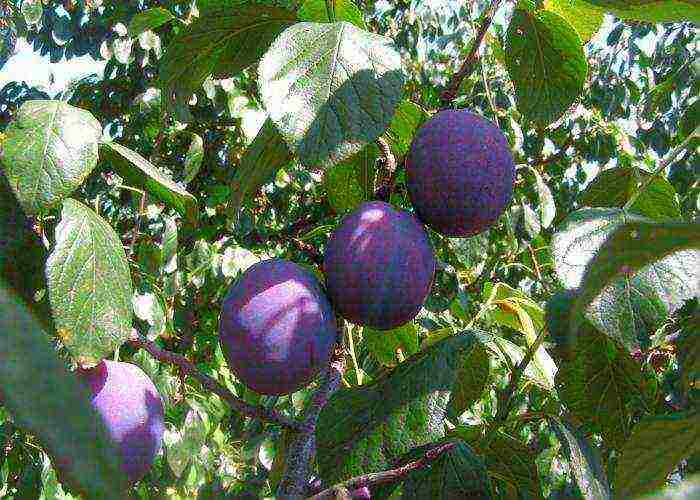
Early ripening high-yielding variety. The plant is medium-sized, the crown is compact. When formed, the fruits look like a slightly rounded oval, the maximum weight of one is 50 grams, the integumentary color is deep purple with a thick bloom.The structure of the pulp is dense, the color is amber, the taste is sour-sweet. The variety stands out among the comrades-in-arms for its frost resistance, the annual yield is stable, the commercial qualities of the fruits are high.
back to contents ↑ Candy
The ultra-early variety got its name from the sweetness of the fruit. The height of the fruit tree does not exceed 3 meters, the plant looks compact. The fruits are round, weighing about 30-40 grams, the color of the thin skin is claret-red with the presence of a bluish bloom. The pulp is sweet in taste, its color is honey-yellow. The variety is well adapted to cold weather, painlessly tolerates frosts down to -20 degrees, and is immune to most common diseases.
back to contents ↑ Red ball
The early ripening plum variety is very popular in many regions, including the Leningrad region. The fruit tree grows to a height of about 2.7 meters, the crown is of medium density, the plant is spreading. The fruits are round in shape and large in size, the weight of one is about 45 grams, covered with a smooth red skin with a bloom. The variety tolerates cold well, the fruits can be transported over long distances.
back to contents ↑ Ksenia

An early ripe large-fruited variety for universal use. The plant does not grow tall. The fruits are shaped like an oval, the weight is 35-40 grams, the skin color is yellow, but there is a red blush, the pulp is sweet in taste, juicy, its color is yellow-green. The variety belongs to the group of self-fertile plum species, it tolerates wintering quite well, the yield is irregular.
back to contents ↑ Honey
From the name it is clear that the taste of the fruits of this early ripening variety of plums, bred in Ukraine, is very sweet. The fruit tree grows up to 5 meters in height, the foliage density is average. The fruits are rounded and rather large, their weight is not less than 40-60 grams, they are covered with a bright yellow skin, the flesh has a similar color, the structure is dense. The fruit is well transported, the variety painlessly survives frosts and dry weather.
back to contents ↑ Tender
A productive early ripening variety. The height of the tree generally does not exceed 2.6 meters, the crown is not dense, spherical. The fruits are round in shape, about 40 mm in diameter, weigh an average of 25-35 grams each, the skin is red in color, and the flesh is yellow, the structure is medium density. The variety is frost-resistant, its immunity to clasterosporium is average.
back to contents ↑ Nika

Representative of early ripening plum varieties. The height of the tree is usually average, but there are also strong-growing specimens, the plant is spreading, the crown is not too dense. The fruits have an oval slightly elongated shape, the average weight is 40-50 grams, reaching biological ripeness, the fruit skin becomes dark purple in color, plaque is present. The structure of the pulp is dense, juicy, sweet on the palate. The variety is immune to common plum ailments.
back to content ↑ Peach
The variety belongs to early maturing and large-fruited, the plant is medium-sized, the crown is not too dense. Fruits are generally rounded, less often ovoid, slightly flattened at the tops, on average weighing 40-50 grams, but sometimes they can reach 70 grams. The skin is dense, has a yellow-green color with a purple blush, the structure of the pulp is dense, juicy, its taste is sweet and sour, the winter hardiness of the variety is quite low, but it is resistant to disease.
back to contents ↑ Renclaude
A variety of home-grown early-ripening plums. The plant is medium-sized, can grow up to 3 meters in height, spreading. The fruits have a round shape, usual for plums, their sizes are rather small (20-25 grams), reaching biological ripeness, they are covered with a yellow-green skin. The pulp of the fruit is juicy, medium-dense. The variety is appreciated by gardeners for its high level of cold resistance.
Back to contents ↑ Blue Gift
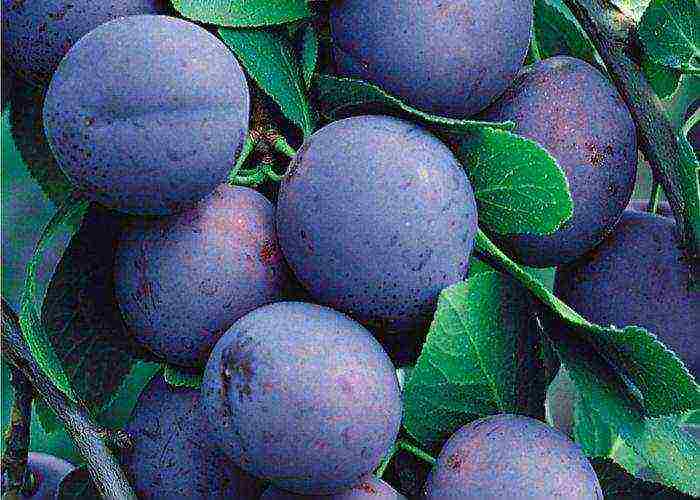
The variety has early maturity dates. The tree does not grow very tall, the crown is not thickened.The oval shape of the fruits and their small size (10-15 grams) distinguish this variety from others, the skin tone is dark purple, and a waxy coating is present. The pulp is green with a yellow tinge, the structure is dense and juicy. The cultivar is self-fertile and does not require pollinator plants.
back to contents ↑ Stanley
A mid-late fruit variety developed by US breeders. The tree is not tall, the crown density is weak. The fruits are ovoid, not even from the sides, large, weighing up to 60 grams, the integumentary color is deep purple, plaque is present. The color of the pulp is yellow, it is fibrous and dense. This variety of plum is quite winter-hardy, but in the regions of Siberia and the Urals it is not very popular.
back to contents ↑ Morning
An early ripe variety of home plum, suitable for cultivation in the Middle lane. The plant is not tall, the crown density is medium. The shape of the fruit is oval, and the mass is about 25-30 grams, the color of the skin is green with yellowness, there is a slight bloom, the pulp has a dense structure, juicy. The fruits tolerate transportation well, the frost resistance of the variety is average, and the resistance to ailments is high.
back to contents ↑ Prunes
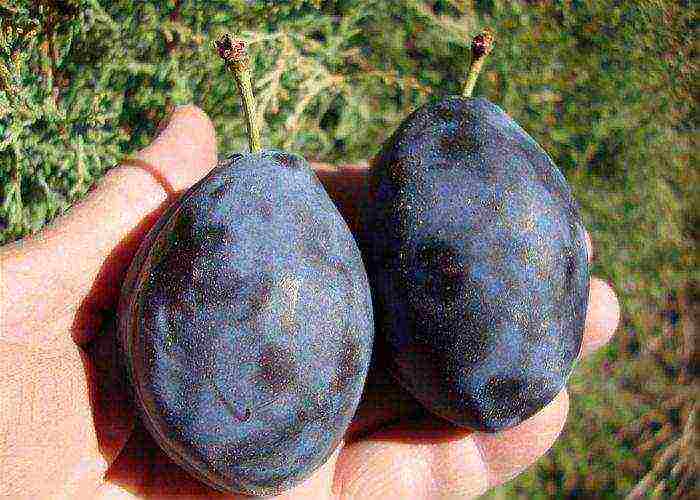
The ripening dates of the fruits of this variety of home plum are medium late. The fruit tree grows quite tall, the crown is not too dense. The shape of the fruit is often rounded, less often rounded-elongated, the mass varies from 40 to 60 grams, the shade of the dense skin is blue-violet, the flesh is yellow, the taste is sweet. The variety is self-fertile, high-yielding and winter-hardy.
back to contents ↑ Study
A variety with early periods of full ripeness of the fruit. Plant height above average, average crown density. The fruits are oval-ovoid, covered with a violet-reddish skin, thick waxy coating. The pulp is juicy, the structure is dense, the taste is sweet with a slight sourness. The variety is appreciated for its high level of winter hardiness and immunity to the main ailments that affect the plum.
When creating your summer cottage garden, you always want the work done to be in vain and eventually bear fruit. There are many fruit trees that are perfect for home growing, but it is worth remembering that each plant variety needs its own conditions, climate, soil, moisture, and more.
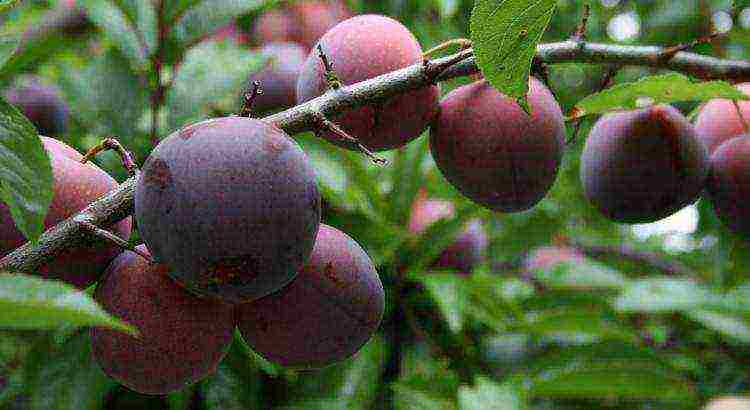
What varieties of plums are most suitable for giving
Plum is one of the most common garden trees, but it is worth remembering that this plant is extremely whimsical and requires constant care. Correctly selected seedlings will delight the gardener with their berries throughout the summer. Also, plums make excellent preparations for the winter in the form of compotes, preserves and marmalades. It is better to give preference to varieties of plums that are suitable for the terrain in terms of climatic indicators and soil characteristics on the site.
There are three main groups of plum trees, most of them take root well throughout Russia, but for some reason there is a very small variety of primitive varieties:
- Early ripening and early varieties - begin to bear fruit from the end of July to the first decade of August and are considered the most productive varieties of plums.
- Mid-season varieties - they begin to harvest from the second decade to the end of August and are considered the most delicious and fragrant varieties of plums, gardeners love to store jam and make tinctures from them.
- Late or very late varieties - begin to bear fruit from late August to mid-September, most varieties are frost-resistant, the fruits are used to harvest preservation for the winter.
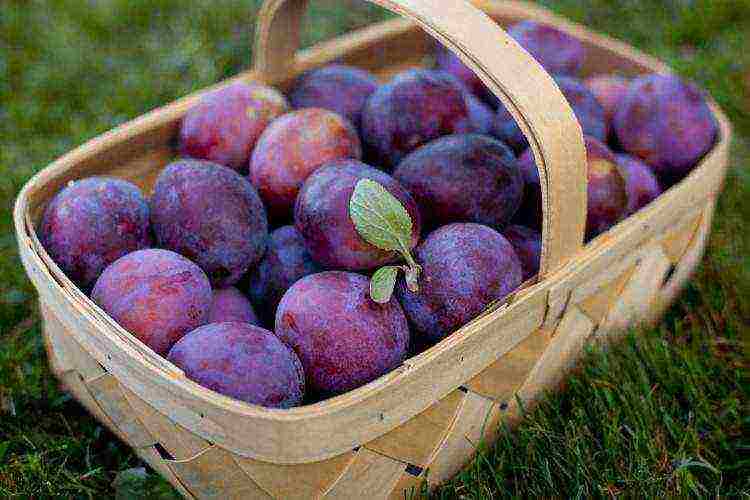
The best varieties of plums for giving
Early varieties of plums
The most optimal option for amateur gardeners, as a rule, trees give a harvest 2-3 years after planting a seedling in the ground, the volume of the harvest increases every year.
- Cooperative - this variety has practically no drawbacks. Typically, the tree is of medium height and has a dense, deciduous crown. The tree blooms in white.The fruits have a rich, reddish-purple hue. The berries are juicy, weighing up to 40 g, very large, regular, oval. The pulp is greenish in color, dense, has a sweet taste with a slight sourness. The bone is easily separated from the pulp. The first harvest will please in three years at best.
- July plum - a very whimsical tree loves sunlight and does not tolerate high humidity. The crown is not too dense, average yield, up to 10 kg per tree. These are red plums with a pointed oval shape, medium or large in size 30–40 g. The sweet variety of plums has a juicy, yellow center. The seedling will delight with the first harvest already three years after planting.
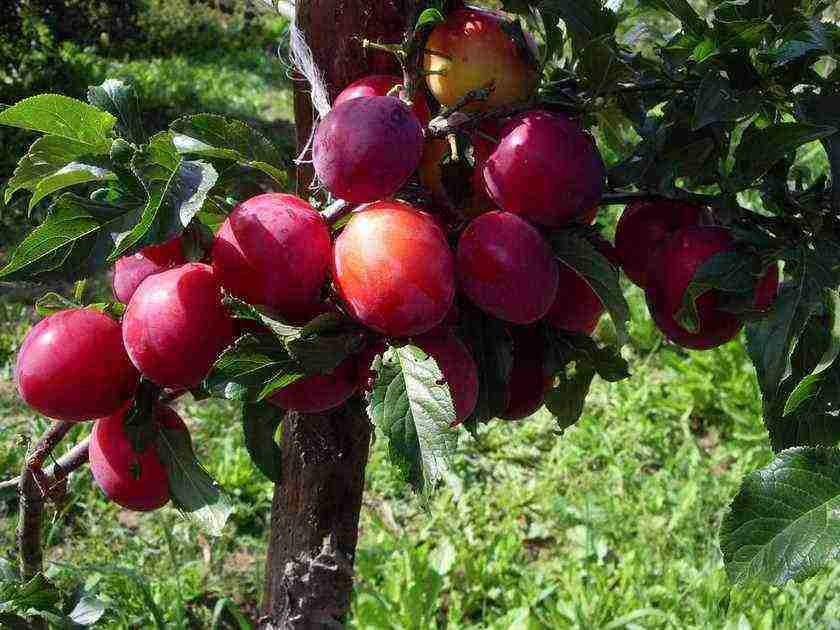
The best varieties of plums for giving
- Plum golden ball Is a variety of yellow plums that has an incredibly pleasant aroma and a peach aftertaste. The peculiarity of the variety is the high yield of grouped fruits, like sea buckthorn, but at the same time they reach very impressive sizes up to 55g. The seedling will delight with the first harvest already three years after planting in the ground.
- Plum Zarechnaya early - the tree reaches a medium height and has predominantly straight branches. The berries are blue-violet with a white silty bloom, rather large, the inner part is yellow in color with a sourish taste. This is one of the most frost-resistant varieties of plums. Gardeners report high yields and disease resistance. Harvesting begins three, maybe four years after the seedling is planted in the ground.
- Plum Early - one of the most frost-resistant varieties of plums. Medium-sized tree with a fan-shaped crown. Red plums have a pleasant, sweet taste, juicy and aromatic. The tree can please with the first harvest already in the second year after planting.
- Red ball - a low-growing garden tree, 2 to 3 meters high. The berries have a rich reddish-amber hue, regular, round shape, large enough up to 45 g. This is a sweet variety of plum, yellowish-white pulp with a rich, pronounced aroma, with a memorable aftertaste. The tree is very fruitful, the first harvest should ripen in 3-4 years, after planting the seedling.
- Plum varieties Record - the tree is very fruitful and frost-resistant. It is rightfully called one of the best varieties of plums for a summer residence, in all respects. The berries are very large, dark blue or purple in color, have a significant waxy film. The pulp can be easily separated from the stone, is quite dense with a yellow tinge, has a very pronounced taste and a pleasant almond aroma.
The best varieties of plums for summer cottages. Photo
Mid-season plum varieties
These plums have a very rich taste and are most suitable for the preparation of fragrant jam or alcoholic tinctures; such trees are often found in home gardens and summer cottages.
- Mashenka - one of the best varieties of plums for summer cottages, has excellent taste. The tree grows medium-sized and cold-resistant, rarely sick and unpretentious to climatic conditions. The berries are dark purple in color, very large. The pulp is dense with a yellowish-greenish color, quite juicy and has a sweet, rich taste, the bone can be easily separated if desired.
- Memory of Babylon - the tree grows to medium size, unpretentious to the climate and grows in cold areas. Berries are bright red, amber, very large up to 90 g. The pulp has a pleasant aroma and pronounced taste with an almond aftertaste, quite juicy.
- Romain - a very productive tree, bears fruit almost every season, the leaves have a characteristic reddish tint. The berries are medium-sized, up to 20 g, red in color, have a rich taste, an amazing almond flavor. The pulp is juicy, deep red.
- Souvenir of the East - low-growing trees with a high yield up to 40 kg per tree. One of the main disadvantages of wood is the instability to cold.The berries are large, maroon or purple in color, have a characteristic sweetish-spicy taste. The flesh is firm and crispy.
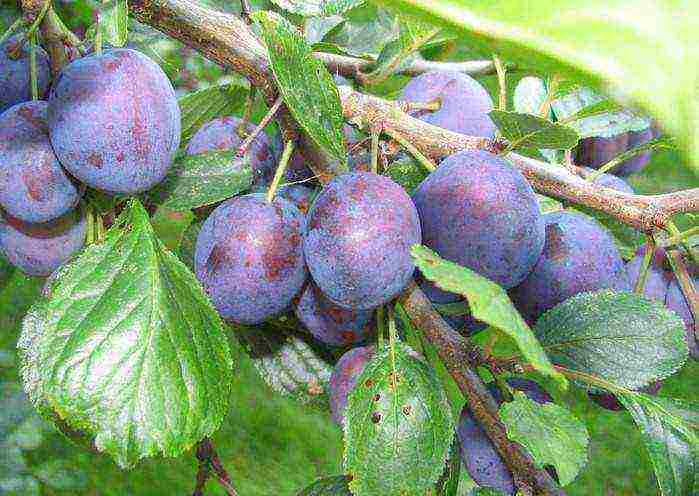
Late varieties of plums
Such plums are the most frost-resistant, but they are inferior in taste to mid-season varieties, while they have a high yield.
- Bogatyrskaya - the tree is unpretentious to climatic conditions, tolerates severe frosts and impresses with its fertility. An adult tree can produce up to 70 kg of berries from one tree. The berries are of a deep dark purple or blue hue, have an elongated oval shape, with a significant layer of waxy bloom. The pulp has a sweetish taste with a slight sourness near the stone itself, yellow in color. The tree is resistant to diseases and parasites.
- Zhiguli - the tree is not very whimsical, it grows in cold conditions and pleases with high fertility. The berries are deep blue or purple in color, reaching an average of 40-50 g. The flesh is greenish, dense and can be easily separated from the stone.
- Svetlana - the tree is not whimsical, resistant to cold weather, reaches an average height, very fruitful. A variety of yellow plum, has a pleasant sweet taste, rich aroma, juicy, firm pulp.
- Empress - a fairly tall tree, reaching an average of 4 m. Harvesting from one tree is 20-25 kg. The berries are dark blue or purple, not too large up to 45g. The pulp is yellow, juicy, aromatic, it is a sweet variety of plum. The first harvest occurs 4-5 years after planting.
- The president - one of the most versatile varieties of plums. The tree is fairly resistant to frost, the fruits of this plum variety are often used to make prunes. The berries have a rich, dark purple hue. The pulp is yellow light, has a pleasant aroma and rich taste, with a characteristic aftertaste of peaches.

The best varieties of plums
The best varieties of plums are determined by the main indicators:
- Frost resistance.
- Productivity.
- Disease resistance.
- Ripening time.
- The size of the fruit.
- Taste qualities.
- How easily the pulp separates from the bone.
- The whimsicality of the plant.
- Convenience of transportation.
From the examples of plum varieties given above, the most widely used ones can be distinguished.
- Early - Cooperative.
- Average - Mashenka.
- Later - Bogatyrskaya.
Often, amateur gardeners prefer high-yielding varieties of plums, but, as a rule, for home planting, it is better to give preference to less-yielding trees, since branches often break from the abundance of fruits, fruits and taste are unnecessarily crumbled, much worse. The average harvest is 40 kg per tree, which is quite a lot for winter harvesting.
Plum varieties - fruits
In order to choose the right plum variety suitable for your area, you need to know the characteristics of each of them. Many take root well and bear fruit in all corners of Russia. Caring gardeners who decide to grow plums can enjoy ripe fruits all summer long, and in winter - prepared aromatic jam and marshmallow.
Plum varieties
Plum varieties are divided into three categories:
- early: July, Zarechnaya early, Skoroplodnaya;
- mid-season: Souvenir of the East, Romain;
- late: President, Empress.
Plum varieties - harvest
The varieties of yellow plum are also distinguished separately, the most popular of them are:
- Egg;
- Altai anniversary;
- Honey white.
Early ripening varieties
Such plums are especially prized for growing for sale, as they bring the maximum profit.
July
Plum varieties - july
The main characteristics are as follows:
- the first fruits ripen at the end of July;
- tree of medium size and density with arched shoots;
- the fruits are red and ovoid, weighing about 30 g;
- the pulp is yellow, sweet in taste;
- the yield from one tree reaches 12 kg;
- begins to bear fruit for 3 years.
Plum of the Yulskaya variety loves the sun and moderate soil moisture.They use it both fresh and preserved.
Zarechnaya early
Plum varieties - early trans-riverine
The early river plum has the following characteristics:
- ripens in mid-July;
- medium-sized tree with straighter branches;
- fruits are large, blue, have a waxy coating;
- the pulp is yellow, sourish in taste;
- regular yield, up to 15 kg of plums from a tree;
- bears fruit for 3-4 years.
This plum belongs to the table and technical consumption and has good taste.
Early
Plum varieties - fast-growing
A winter-hardy plum, it has the following characteristic qualities:
- ripening occurs in July-August;
- the crown of the tree is fan-shaped;
- fruits are small, up to 25 g, red;
- the pulp is juicy and aromatic;
- begins to bear fruit for 4 years;
- average yield - 10 kg per tree.
The life span of a fast-growing plum is up to 20 years. It is well transported and belongs to dessert varieties.
Mid-season varieties
The varieties ripening in the middle of summer are especially appreciated by gardeners, since they have the brightest and most intense aroma. It is from these fruits that the most delicious tinctures and jams are obtained.
Souvenir of the east
Plum varieties are a souvenir of the east. Harvested crop
Quite a popular variety of plum, bred by selectors. Main characteristics:
- grows not high, up to 2.5 m;
- plum fruits are large, beautiful, dark blue, weighing up to 40 g;
- the pulp is yellow, dense, crispy, sweet in taste;
- the yield indicator reaches 40 kg per tree.
An excellent table variety of plum with a high level of fruiting. It is used in the same way as the technical one.
Romain
Plum varieties - romaine
Plum Romaine has the following qualities:
- ripens in mid-August;
- leaves are reddish;
- the fruit is red, like the pulp;
- average fruit size (20-25 g), are of high quality.
This plum is great for growing in a summer cottage. Bears fruit regularly, is used both for food and for winter harvesting.
Late plum varieties
Used for harvesting and storing plums for the winter, often used for conservation. Most of the late varieties are frost-resistant and grow well in the northern strip of Russia.
The president
Late plum varieties - president
Plum President is universal in application. Character traits:
- ripening falls in the middle of September;
- large fruits, weighing up to 50 g, have a blue color with a waxy bloom;
- the pulp is yellow, juicy;
- a middle-aged tree brings up to 40 kg of yield, an adult - up to 70 kg.
The fruits of the President plum are perfectly transported and stored for up to 2 weeks. They are used to make prunes. The tree is winter-hardy.
Empress
Late plum varieties - empress
The table variety of plum has the following qualities:
- tall tree, up to 4 m in height;
- the yield from one tree is up to 20 kg;
- bears fruit for 4-5 years;
- ripening of fruits falls in the second half of September;
- plum color is dark purple, average weight 45-50 g;
- the pulp is yellow, juicy.
This plum is used for juicing and preservation. Well transported.
Plum yellow varieties
Recently, gardeners prefer yellow ones when choosing plums. There is a misconception that this fruit should be blue, and the yellow varieties of plums are cherry plums. Not at all, they differ in both external and taste characteristics.
Egg
Plum yellow variety - Egg
Egg plum tolerates winter frosts and summer droughts well. Characteristic differences:
- average ripening period (August-September);
- fruits are large, round, weighing up to 50 g;
- quickly deteriorate, stored for less than a week, easily rot during the rainy season;
- bears fruit in the 6th year.
This type of plum is of medium quality and belongs to technical type.
Altai anniversary
Plum yellow varieties - Altai Jubilee
It takes root well both in the northern and southern regions. Differs in the following qualities:
- early maturation;
- fruits are medium, round, weighing about 15 g;
- the color is yellow with red, has a white bloom;
- the pulp is loose and juicy;
- bears fruit in the 3rd year.
It is easily exposed to chlorosis and attacks of pests such as seed plants. Such a plum is not suitable for fresh transportation.
Honey white
Plum yellow varieties - Honey white
Yellow honey plum tastes like the product of the same name. Has the following characteristics:
- ripens early (mid-July);
- the height of the trees reaches 5 m;
- fruits are round, medium (up to 30 g);
- the pulp is juicy and sweet.
The honey plum is frost resistant and has a high yield.
How to choose the right plum sapling Plum varieties - Saplings
In order for the plum tree to begin bearing fruit on time and in the desired volume, it is necessary to take seriously the choice of good and healthy planting material.
Basic requirements for seedlings
It is customary to use plum seedlings for planting, the age of which does not exceed 2 years. In order to grow a large tree with a good crown in the future, sprouts with at least three branches in different directions and the main conductor (in the future, the trunk) are used.
Root length should be up to 40 cm with a good and clean root collar. The average thickness of a plum sapling is 2.5 cm.The length of the skeletal (main) branches reaches 50-60 cm.
Rules for the transportation and storage of seedlings
It is best to choose plum seedlings for planting with a closed root system, they are usually bought in autumn or spring. If the roots are not in the ground, they must be wrapped in a wet cloth or grass before transporting them, straw is also suitable. The resulting package is tied with twine. In this form, the seedlings can be transported. In no case should the roots dry out.
Outcome:
Plum has a huge number of varieties, so everyone can choose the one suitable for growing in their area and depending on taste preferences. If you purchase good planting material and follow the recommendations for care and planting, then the result will not be long in coming.
Plum is a fruit crop, a place for which every amateur gardener finds on his personal plot. If you choose the right variety, plums can be grown in most regions of Russia. Breeders have created a large number of winter-hardy varieties and hybrids, zoned for the conditions of a long frosty winter. This fruit crop is relatively fast-growing, which means that a few years after planting, you can count on the first significant harvest.
A variety of varieties with fruits of various colors and ripening periods, unpretentious care, make the plum one of the most common crops in amateur and industrial gardens. For the middle lane, it is preferable to choose plum varieties with early and medium-early ripening, so that the peak of fruiting ends before the first frost.
The content of the article:
- 7 best varieties of plums
- Early plum varieties
- Mid-season varieties
- Late plum varieties
- Yellow plum varieties
- Chinese plum
- Other varieties of plum
- How to choose the right plum sapling?
- Basic requirements for seedlings
- Rules for the transportation and storage of seedlings
- conclusions
7 best varieties of plums
These varieties are distinguished by increased resistance to diseases and pests, good winter hardiness and dessert fruit taste.
-
Fast-growing. An early variety, ripening by 1-2 decades of August, has exceptional frost resistance. The variety is not affected by fruit rot, has increased resistance to major diseases and pests of stone fruit crops. Fruits of a reddish hue with yellow sweet pulp weighing up to 30 g. Plum of this variety tolerates drought, during the period of lack of moisture neither growth nor fruiting suffer.
-
Yakhontovaya. Plum of this variety has excellent frost resistance and resistance to insect pests and diseases of fruit crops.Fruits of yellow color have a light waxy bloom, a pronounced sweet and sour taste, reach a mass of 30 g. Plum of the Yakhontovaya variety is drought-resistant, for 3 years after planting, 50 kg of fruits can be harvested from the tree.
-
Tula black. The variety is characterized by a high level of immunity to major diseases and pests of stone fruit crops, taste and frost resistance are somewhat lower than those of previous crops. The main purpose of the dark blue fruits of sweet and sour taste is to use for preparations, preparation of dried fruits. The fruit ripens in mid-September.
-
Chinese. A winter-hardy variety of medium early ripening (mid-September) has a high immunity to pests and diseases of fruit trees. The variety has large, red fruits weighing up to 70 g with a delicate sweet taste.
-
Blue gift. The sweet fruits of this variety weigh a little - only 15 g. They ripen in 1-2 ten days of August, the tree is frost-resistant, rarely exposed to diseases.
-
Giant. Delicate fruits of this variety correspond to the name - they reach a weight of 110 g, have a pleasant taste, sweet without cloying. Trees of this variety are not resistant to fungal diseases, winter hardiness is low.
-
Stanley. An old variety of American selection, popular today. Located in the state register of the Russian Federation, it is recommended for cultivation in the south of Russia. Medium-sized trees reach a height of 3 m and have a sparse crown. Large and very large fruits of dark purple and green color are covered with a waxy coating. The pulp of this type of plum is sweet, dense and aromatic, the stone is separated. The purpose of the variety is to use it as a dessert, for drying for future use, for homemade preparations.
All of the above varieties of plum are distinguished by their early maturity (getting the first harvest from the third year of life), good yield. They are used as a dessert or raw material for preparations: preparation of compote, jam, jam, pastilles, etc. Plums of these varieties are transportable, that is, they are suitable for transportation over long distances.
|
Early Yakhontova Tula black Chinese Blue gift Giant Stanley |
Early plum varieties
Early ripening varieties are attractive for commercial use of the crop, as the crop can be sold profitably.
-
July. Plums of this variety are used as a dessert and for preparations. The ripening period of red fruits with yellow and sweet pulp is the end of July. The yield is 12 kg per tree, the first harvest is taken already at the 3rd year of the tree's life. The average weight of ovoid fruits is 30 g. The tree has an average height, average foliage, shoots take an arched shape. Plum of this variety prefers abundant sunlight throughout the day and moderate soil moisture.
-
Zarechnaya early. The ripening period for large blue fruits of this variety is mid-July. The pulp of the fruit is yellow, has a pleasant sour taste, the plums are covered with a waxy coating. The tree of the Zarechnaya early variety bears fruit regularly, from 3-4 years of age, the average yield is 15 kg per tree. The purpose of the fruits is to be used as raw materials for blanks.
-
Fast-growing. The variety has increased winter hardiness, the fruit ripening period is late July-early August. Small fruits with red skin are transportable, have aromatic juicy pulp. The yield of the variety is 10 kg per tree, the Skoroplodnaya plum begins to bear fruit at the 4th year of life. The purpose of the fruit is to be used as a dessert.
|
July Zarechnaya early Early |
Mid-season varieties
Plums of medium ripening always find their connoisseurs among gardeners, as they have a bright color and rich taste. Fragrant fruits are most often used for harvesting and home winemaking.
-
Souvenir of the East. The table variety obtained as a result of selection work is characterized by a high yield (up to 40 kg per tree) and large, beautiful fruits with crispy, sweet pulp.The crown of the tree is low, located at a height of no more than 2.5 m. The color of large fruits is dark blue, weight - up to 40 g, the color of the pulp is yellow. The purpose of the crop is to use it as a dessert, technical processing.
-
Romain. Used in amateur gardens, ripens in the 2nd decade of August. The variety is distinguished by regular fruiting, has a reddish foliage. High quality fruits of medium size (up to 25 g), have a red skin and the same color flesh. Used for dessert and for processing for the winter.
|
Souvenir of the East Romain |
Late plum varieties
Most often they are used for conservation and preparation for the winter in the form of dried fruits, they have good frost resistance. Gardeners of the middle lane and northern regions should be selective in choosing late-ripening varieties, since they can lose most of the harvest due to early September frosts.
-
The president. The ripening period is mid-September, the tree of this variety is extremely productive, with good care you can get from 40 to 70 kg of large blue fruits with juicy yellow pulp. The purpose of the fruits is universal, suitable for obtaining prunes, long-term storage and transportation.
-
Empress The tree of this variety is tall, up to 4 m in height, ripening period is 2-3 decades of September. Plum of this variety begins to bear fruit at 4-5 years of age. It gives about 20 kg of dark purple large fruits with yellow and juicy pulp (up to 50 g). Purpose - processing and procurement.
|
The president Empress |
Yellow plum varieties
Plum of yellow varieties resembles cherry plum in color, but these two crops are radically different from each other, both in taste and in appearance.
-
Egg. The tree of this variety perfectly adapts to unfavorable weather conditions. Large, round fruits of mediocre taste ripen in late August and early September. They cannot be stored for a long time, they deteriorate already 4-5 days after collection. The beginning of fruiting occurs at the 6th year of the tree's life. The purpose of the fruit is processing for canning.
-
Altai Jubilee. It takes root equally well both in the south and in the northern regions. The early ripening variety has small yellow-red fruits with juicy, friable flesh. The beginning of fruiting is 3 years of the tree's life. It is susceptible to chlorosis and pest attacks. Plum of this variety is not transportable over a long distance.
-
Honey white. The taste of the fruit is true to the name, its pulp is juicy and sweet. Tall tree (up to 5 m), early ripening, round, medium-sized fruits. The variety has a high yield, winter hardiness.
|
Egg Altai Jubilee Honey white |
Chinese plum
This culture is a rarity in our gardens. Its fruits are attractive and delicious. The Chinese inhabitant is environmentally friendly, more frost-resistant, early in fruiting. This type of plum is characterized by an unusual flowering: the crown is covered with a dense ball of inflorescences, making the landscape spectacular and unique. The flowering period occurs in rainy, cool weather, so flowers that are not able to self-pollinate do not receive the help of insects. To solve this problem, cherry plum should be planted next to the Chinese plum, it is a reliable pollinator. The fruits of the plant are red or yellow, heart-shaped. The pulp is juicy, with an adherent bone and a special taste.
Sorts of Chinese plum: "Red ball", "Skoroplodnaya", "Red meat", "Golden ball", "Jubilee", "Seedian Shiro". The "Golden Ball" tastes like pineapple.
Found a mistake in the text? Select it and a few more words, press Ctrl + Enter
Other varieties of plum
The wide range of plum varieties offered by breeders allows the selection of seedlings for different climatic conditions.
-
Top hit - a late-ripening variety with large egg-shaped fruits (up to 80 g) with tasty pulp with a slight sourness.
-
General's - a frost-resistant variety for technical purposes, has small red fruits with soft pulp, making them non-transportable. Low-growing trees are frost-hardy, they are distinguished by abundant flowering at the end of May.
-
Morning - the variety has medium-sized green-yellow fruits with yellow juicy pulp.
-
Nenka - a high-yielding and frost-resistant variety with medium-sized fruits (up to 22 g). The tree is medium-sized, the crown has a wide pyramidal shape.
-
Alyonushka - the variety is derived from the Chinese plum, so the leaves of the tree with a spherical crown are similar to the leaves of a peach. Sweet large fruits of dark pink color have an inseparable pit.
-
Chemalskaya large - a fast-growing variety, yields a harvest for 3-4 years, frost-resistant, needs pollinating varieties. Both the buds and the wood are frost-resistant, the tree needs sufficient watering.
-
Spike-shaped blue suite - a high-yielding mid-season variety with juicy and sweet fruits weighing up to 60 g. The crown of the tree is compact.
-
Red ball - a dessert variety of large-fruited plum with rounded red fruits with a juicy, light yellow pulp. The tree is medium-sized, up to 2.5 m tall, the fruits are transportable.
-
Eurasia 21 - a tall tree with red-burgundy juicy and sweet-sour fruits with a waxy bloom. Fruit weight up to 35 g.
-
Tula black (Bryansk late) - a high-yielding, self-fertile variety with an average ripening period. It has medium frost resistance, dark blue oval fruits with reddish flesh.
-
Blue gift - mid-season, self-fertile, high-yielding variety. Large fruits have excellent taste, dark purple color.
-
Early ripening red - early maturing self-fertile variety of folk selection ripens in August. Oval fruits with sweet firm flesh are purple in color.
-
Oh yeah - an unpretentious early ripening variety, even on loamy soil, gives high yields. Requires the introduction of a large amount of organic matter and sufficient watering. The stunted tree is annually strewn with purple fruits with a fleshy sweet and sour pulp.
-
Kuban legend - a medium-sized tree has a pyramidal crown. Egg-shaped red-violet fruits with green flesh reach a weight of 35 g.
-
Vicana - the variety is zoned for the northwestern regions. A stunted tree has a thin weeping crown. The mass of oval burgundy fruits reaches 25 g, their stone is easily separated from the pulp. Plum is suitable for both dessert and canning.
-
Valor - mid-season variety of Canadian selection. Large egg-shaped blue fruits with juicy greenish-creamy flesh reach a mass of 50 g.
-
Memory of Timiryazev - a medium-sized tree with a weeping crown has oval juicy fruits with a yellowish pulp. Plum stone with lilac skin is easily separated from the pulp.
-
Hungarian - a transportable variety intended for the production of prunes. The dark red oval fruits have a sugary firm flesh with a sweet taste. The bone is easily detached.
-
Mirabel - plums of this variety are similar to cherry plum, but unlike it they have a sweet pulp and an easily separated stone. Small fruits are oval in shape with pointed ends.
-
Ternoslum - a low-growing tree with excellent adaptability to various growing conditions. The variety is unpretentious to care, has a high yield, its purpose is conservation.
-
Damascene - has oval fruits of various colors (white, black, blue, yellow).
-
Canadian plum - the variety is self-fertile, needs additional pollination, due to early flowering it is not afraid of spring frosts.
-
Burbank Giant - a frost-resistant diploid variety with large fruits of excellent taste. Resistant to monoliosis.
-
Kabardinka - the variety was created by breeders of the Stavropol Territory and Kabardino-Balkaria. Mid-season, ripens in mid-August. Spherical fruits have a very tasty pulp, reaching a mass of 45 g.
-
Angelina - the variety is characterized by a powerful crown that needs to be shaped to accelerate fruiting. Plums of this variety are early-growing, begin to yield the harvest 3 years after planting. The fruits are similar to those of cherry plum.
-
Mashenka - medium-sized tree of early ripening. Dark pink fruits with yellow flesh have an excellent dessert taste.
|
Top hit General's Morning Nenka Alyonushka Chemalskaya Spike-shaped blue suite Red ball Eurasia 21 Tula black Blue gift Early ripening red Oh yeah Kuban legend Vicana Valor Memory of Timiryazev Hungarian Mirabel Ternoslum Damascene Canadian plum Burbank Kabardinka Angelina Mashenka |
How to choose the right plum sapling?
The first step towards future high yields is choosing a healthy seedling, prepared for sale and transportation according to all the rules. It is best to purchase young plum trees from nurseries where they are cultivated by professionals.
The initial examination of a plum sapling is an assessment of the condition of the bark and kidneys. The bark should not be damaged, and the buds should be slightly swollen and greenish when purchased in spring. Dry, dry buds are a sign of death or freezing of the tree.
Basic requirements for seedlings
A plum seedling suitable for planting can be annual or biennial. An annual seedling has a thin, even trunk without branches. A two-year-old seedling is a trunk (at least 2.5 cm in diameter) with 3-4 branches - the rudiments of skeletal branches 50-60 cm long. Both those and others take root well in a new place, although two-year-olds begin to bear fruit faster. Three-year-old plum seedlings are more sensitive to replanting.
When choosing a seedling, special attention should be paid to the health of the roots. The root system should be fibrous, with a central root and many branches and thin roots.
Rules for the transportation and storage of seedlings
Optimal terms for purchasing and planting plums in the middle lane:
-
End of March - beginning of April;
-
End of September - beginning of October.
For the south of Russia, these terms are shifted by 2-3 weeks forward (in spring) or backward (in autumn).
Seedlings with a closed root system take root best. A reliable seller will make sure to cover the roots of the seedling with a clay mash before selling it to protect it from drying out and damage during transportation. If the root system is not protected, and the seedlings need to be transported, their roots are wrapped in a damp cloth, grass, straw. If the root system is dry, there is a risk of death of the seedling.
conclusions
A large assortment of zoned plum varieties, suitable for growing in most regions, allows you to purchase planting material to your liking. The choice of a high-quality seedling with the expected characteristics, proper planting and care will definitely reveal the possibilities of the variety and help to get a good harvest.
The author of the article: Alexey Kuzmin, expert agronomist, especially for the site
